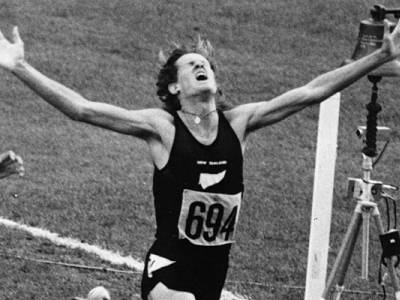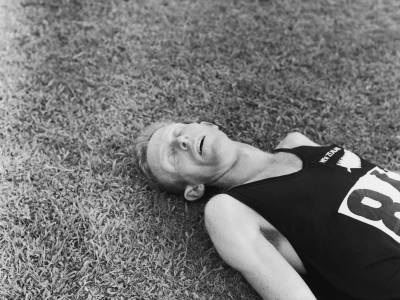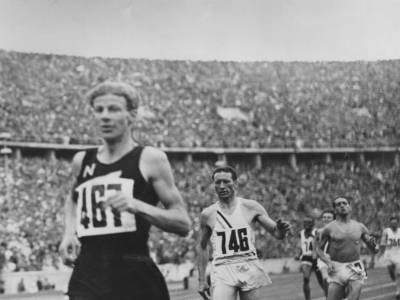It is a simple piece of clothing. At first glance, perhaps, nothing extraordinary.
Yet for more than a century, New Zealand’s Olympic athletes have worn the black singlet with unadulterated pride. Emblazoned with the silver fern, it has become an iconic symbol of strength and courage, passion and inspiration, resilience and honour. The black singlet has even been known to strike fear in the hearts of rivals.
The Black Singlet campaign will explore the legacy of our inspirational champions who have donned it, and uncover the pride and aspirations of those who will wear it in Rio 2016.
Why New Zealand first adopted black as its national sporting colour isn’t exactly black and white.
But it’s clear that it began with rugby. In 1888 the New Zealand “Natives” team toured Britain wearing an all-black playing uniform, and five years later, the newly-formed New Zealand Rugby Union decreed the national representative colours would be “black jersey with silver fern leaf, black cap with silver monogram, white knickerbockers and black stockings”.
The silver fern first became a symbol of bravery, sacrifice and allegiance when the New Zealand Army wore it during the Boer War at the turn of the 20th century. The fern is engraved on the tombstones of those who New Zealanders fell during both World Wars.
The black singlet was also the unofficial uniform of hardworking Kiwis on the land – the likes of farmers, shearers and truck drivers – appreciated for it coolness in summer, and its knack for disguising dirt.
New Zealand’s Olympic history began back in 1908 at the London Games, when the Kiwi athletes were part of an Australasia team. Although the emblem on their shirts bore a tiny kiwi and silver ferns beneath an emu and kangaroo, the uniform colours - dark green and wattle yellow – were distinctly Australian.

The 1908 Australasian Team
Not everyone was impressed with the Australasians’ attire as the team marched behind flagbearer, New Zealand hurdler Henry St Aubyn Murray, at the first opening ceremony ever held at an Olympic Games. In his book Olympic Follies: The Madness and Mayhem of the 1908 London Games, Graeme Kent wrote: “While most of the other teams were wearing well-cut athletic uniforms, the completely unsubsidised Australasians looked more like a rag-tag-and-bobtail outfit. Some contestants were wearing t-shirts and shorts, while others were in swimming costumes. Most were wearing ill-fitting green caps.”

The 1908 Australasian Team emblem - Noting the Silver Fern
It didn’t seem to impair their performance, however. In his sleeved jersey and loose draws (as the Games rules demanded), Harry Kerr became the first New Zealander to win an Olympic medal, taking out bronze in the 3500m walk.
What nearly cost him was his tardiness. Busy chatting with officials under the grandstand, he almost missed the start of the race.
In 1912, Malcolm Champion wore a black swimming costume when he won our first gold medal as part of the Australasian men’s 2 x 400m freestyle relay team. Although born in Norfolk Island, Champion came to live in New Zealand at the age of 11, and dominated swimming in his new country for more than a decade. The “husky and powerful swimmer” proudly carried the Australasian team flag at the opening ceremony in Stockholm.

New Zealand's first Gold Medalist Malcolm Champion
But it wasn’t until the 1920 Olympic Games in Antwerp that a team marched under the New Zealand flag, and the four athletes competed in black singlets with the silver fern emblem hand-sewn over their hearts.

The 1920 New Zealand Olympic Team wearing the first version of 'The Black Singlet'

Wearing the Silver Fern with Pride
Violet Walrond, New Zealand’s first female Olympian, also tucked a fern frond into her hatband. Aged only 15, Walrond made the finals of both the 100m and 300m freestyle – swum in cold, murky canal waters – and remains the youngest New Zealand Olympian to wear the silver fern.
The original New Zealand team singlets were made of 100 percent cotton. Raw cotton was shipped to New Zealand, where the yarn was spun to knit the fabric. Rower Darcy Hadfield wore the black singlet as he powered to bronze in the men’s single sculls on the Canal Vilvoorde near Brussels. But his singlet may have been a hindrance rather than a help.
There were pros and cons in uniforms fashioned from cotton. The porous yarn readily soaked up moisture, making it comfortable to wear. On the downside, it held onto sweat, making it wet and heavy; the sweat residue would eventually rot the fabric.
Compare it to today’s hi-tech singlet - made from synthetic fibres which not only mimic cotton’s breathability and comfort, but also dry quickly.
Fortunately, the other scullers were in the same boat as Hadfield, so to speak. But he had other hurdles to overcome. Hadfield - a shipwright by trade who was wounded during fighting at Passchendaele in the First World War - was at a disadvantage to his European counterparts, after a serious lack of preparation during his seven-week boat journey from Auckland to Belgium.
Nevertheless, Hadfield’s bronze was the first stroke in New Zealand’s brilliant tradition in Olympic rowing. By the end of the 2012 London Games, New Zealand rowers had won 21 medals (nine gold, two silver and 10 bronze).

Darcy Hadfield in his black singlet wins Bronze in 1920
Tweet Share



